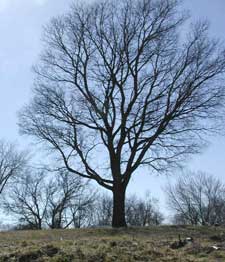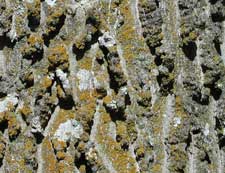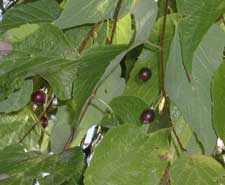Resource Library
Plant of the Week: Hackberry
The University of Arkansas System Division of Agriculture does not promote, support or recommend plants featured in "Plant of the Week." Please consult your local Extension office for plants suitable for your region.
Plant of the Week
Hackberry
Latin: Celtis occidentalis

I'm a folk music fan who has spent lots of time listening to incredibly talented performers almost no one has ever heard of. Though I have long pondered the intangibles distinguishing the few superstars from the majority who toil away in anonymity and poverty, I've never been able to identify the cause.
The same thing happens with trees. Some shine and everyone knows their name while others, like the hackberry, go by unnoticed in the background.
Hackberry, Celtis occidentalis, is a native deciduous tree found throughout much of the Eastern and Plains states where it grows along streams, roadways or in fence rows. It doesn't occur in the Gulf Coastal Plain, where it's replaced by a related species, the sugarberry. Trees usually grow in the 60- to 70-foot tall range with a rounded, symmetrical crown.
Hackberry is easiest to identify by its bark. On young trees or smaller branches, the bark is smooth and gray except where thick, warty bark patches develop. As the tree ages, these patches coalesce to form deep, furrowed ridges.
Common hackberry has 3- to 5-inch long ovate leaves with a pointed tip and serrated margins. In the summer, they're a medium green; in the fall, they turn yellow early in the season. Hackberry doesn't have a heavy leaf load like oaks or maples, so growing plants beneath them is easy.

Nondescript flowers appear in the spring with the leaves. In the fall, red to brown pea-sized berries are produced. The berries have one large, hard seed covering with a sweet, dry pulp. Berries are favorites with birds, possums and little boys.
The obscurity hackberry resides in is long standing. Even the Latin name "Celtis," given to it by the famous botanist Linnaeus, is a misapplied Greek name for a completely different tree. Native Americans had no special name, so English colonists called it hagberry (what we now call bird cherry, Prunus avium), a familiar tree back home.
This name eventually morphed into hackberry.
Hackberry is a tough, worker-bee kind of a tree. I've never seen the word "stately" applied to a hackberry as you might with elms, oaks or maples. It grows in almost any soil, including dry, compacted sites that would be the death of more "stately" trees.

Though not commonly offered in Arkansas nurseries, the tree is occasionally used in the Plains states and the upper Midwest. Selected forms are described but not commonly offered. Selected forms such as ‘Chicagoland' or ‘Prairie Pride' are immune to the mite causing the hackberry witches' broom, the most disfiguring of the several ailments that can befall this species but seldom slow it down. Hackberry might be worth seeking out for non-irrigated parking lot islands and other inhospitable locations.
By: Gerald Klingaman, retired
Extension Horticulturist - Ornamentals
Extension News - January 5, 2007
The University of Arkansas System Division of Agriculture does not maintain lists of retail outlets where these plants can be purchased. Please check your local nursery or other retail outlets to ask about the availability of these plants for your growing area.